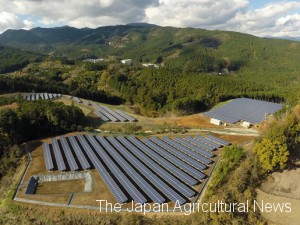Enlightenment of region by “bundo” and “suijo”

Bust statue of Sontoku Ninomiya and Ryoichiro Okada, located in the schoolyard of the Kakegawa city mmunicipal north junior high school (Kakegawa city, Shizuoka prefecture)
Every year, board of education of Kakegawa city of Shizuoka Prefecture, where headquarters of Dainippon Hotokusha is located, distributes supplementary readers “Naruhodo, Nattoku, Kinjiro-san (I see, I’m convinced, Mr. Kinjiro)” to 4 grade students of the elementary school. This book explains Sontoku’s philosophy ” kinben (hard work)”, ” shisei (sincerity)”, “bundo (computational general equilibrium)”, “suijo (concession)” in line with the everyday lives of children.
For example, the book represents “bundo (computational general equilibrium) ” as ” to eliminate the waste (pocket money, eco-movement),” and “suijo (concession)” as “to lend force or help the people (volunteer activities, such as fund-raising activities).”
The statues of Kinjiro Ninomiya were built at all the 22 elementary school in Kakegawa city by donation of citizens until the end of last year. In March, Two Bust statues of Sontoku Ninomiya and his disciple Ryoichiro Okada(1839 ~ 1915), the second president of Dainippon Hotokusha, were alongside built in the schoolyard of the Kakegawa city municipal north junior high school.
Power plant based on the investment by citizens

Solar panels of Odawara mega solar citizen power plant on a hill (provided by Hotoku energy Co., Ltd. in Odawara city, Kanagawa Prefecture)
In Odawara city of Kanagawa Prefecture, Sontoku’s hometown, there is also flowing “Sontoku ism” in the private enterprises. 38 companies of the city such as Kamaboko (boiled fish paste) stores and electronics stores invested 58 million yen and founded the solar power generation plant company “Hotoku Energy Corporation Co., Ltd” in 2012. The company accepted citizens’ investment of 100,000 yen per 1 share. Currently 169 people invested about 1000 shares. From electricity sales gains, investors can receive 2% of dividend.
According to Masahiko Kokorozawa, vice president of the company, trigger of the movement was the Great East Japan Earthquake that occurred in 2011. “Cars disappeared in the road to go to Hakone area, there were also planned power cut, and radioactive cesium was detected from Ashigara tea. We were aware that our lives were based on the safety and peace of mind.”
The movement of the city office was also quick. The office gathered local companies and established the energy commercialization study council. The city applied for community-led renewable energy business promoted by the Ministry of the Environment. Forest owners provided mountain for the site of solar power generation. The company set 4020 sheets of polycrystalline panels in the 1.8ha of site. Since autumn of 2014, the company is running as “Odawara mega solar citizen power plant,” generate 1.02 million kw of electricity per year, expects 45 million yen of revenue per year. The company set Panels for solar power generation at roofs of 5 Municipal Elementary School. Generated electricity is saved at the battery to be planned to use in the shelter in case of emergency.
◇
Hotoku movement, from the late Edo period to Meiji period, spread mainly in rural areas of the Kanto and Tokai region, the number of Hotokusha was more than 1000. A factor of rapid expanding is the movement accompanied with not only morality but also economic activity. Currently 58 Hotokusha exist. In past, the companies removed financial activities to commercial banks and transferred agricultural business to Agricultural cooperatives (JA). Now many of Hotokusha left from rescuing the poor, put the emphasis on edification activities to spread the spirit of mutual aid and Sontoku thought among the members.
In 1996, Junichi Shinmura, president of Dainippon Hotokusha, who had experienced the mayor of Kakegawa city, proposed the “Sontoku Ninomiya Summit” to local governments across the country with common band of Sontoku and Hotokusha. Currently 17 municipalities join and open the conference with a rotational basis every year. In 2015, the conference is to be held Toyokoro town in Hokkaido island in October.
President Shinmura said, “According to the teachings of Hotoku, policies to improve the economy by increasing the consumption and income while expecting economic growth are not good for environment and social disparity.” and continued this way, “When we face the declining birthrate and aging society, we must reduce the amount of consumption and improve the quality. For that reason, we should adopt a cooperative spirit that leads to Hotoku’s “bundo” and “suijo.”

